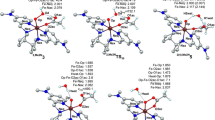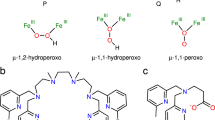Abstract
The present computational study complements the recent experimental efforts by Karlin and coworkers to describe the interconversion of nitrite to nitric oxide by means of an iron porphyrin complex together with a Cu chemical system, i.e., the iron(II) complex (F8TPP)FeII [F8TPP = tetrakis(2,6-difluorophenyl)porphyrinate(2−)] and a preformed copper(II)–nitrito complex [(tmpa)CuII(NO2)][B(C6F5)4] [tmpa = tris(2-pyridylmethyl)amine], being the latter an oxidized species of [(tmpa)CuI(MeCN)]+. By DFT calculations, we unravel how the reduction of nitrite to nitric oxide takes place through a μ-oxo heme-FeIII–O–CuII complex, following a mimetic path as in the cytochrome c oxidase. Mayer bond order (MBO) and energy decomposition analyses are used to analyze the bonding strength of such nitro derivatives to either copper or iron.






Similar content being viewed by others
References
Seinfeld JH, Pandis SN (2006) Atmospheric chemistry and physics: from air pollution to climate change. Wiley-Interscience, Hoboken
van Faassen EE, Bahrami S, Feelisch M, Hogg N, Kelm M, Kim-Shapiro DB, Kozlov AV, Li H, Lundberg JO, Mason R, Nohl H, Rassaf T, Samouilov A, Slama-Schwok A, Shiva S, Vanin AF, Weitzberg E, Zweier J, Gladwin MT (2009) Nitrite as regulator of hypoxic signaling in mammalian physiology. Med Res Rev 29:683–741
Tavares P, Pereira AS, Moura JJG, Moura I (2006) Metalloenzymes of the denitrification pathway. J Inorg Biochem 100:2087–2100
Zumft WG (1997) Cell biology and molecular basis of denitrification. Microbiol Mol Biol Rev 61:533–616
Poole RK (2005) Nitric oxide and nitrosative stress tolerance in bacteria. Biochem Soc Trans 33:176–180
Schopfer MP, Wang J, Karlin KD (2010) Bioinspired heme, heme/nonheme diiron, heme/copper, and inorganic NOx chemistry: ·NO(g) oxidation, peroxynitrite-metal chemistry, and ·NO(g) reductive coupling. Inorg Chem 49:6267–6282
Samouilov A, Kuppusamy P, Zweier JL (1998) Evaluation of the magnitude and rate of nitric oxide production from nitrite in biological systems. Arch Biochem Biophys 357:1–7
Dezfulian C, Raat N, Shiva S, Gladwin MT (2007) Role of the anion nitrite in ischemia-reperfusion cytoprotection and therapeutics. Cardiovasc Res 75:327–338
Poyton RO, Castello PR, Ball KA, Woo DK, Pan N (2009) Mitochondria and hypoxic signaling: a new view. Ann NY Acad Sci 1177:48–56
Feelisch M, Fernandez BO, Bryan NS, Garcia-Saura MF, Bauer S, Whitlock DR, Ford PC, Janero DR, Rodriguez J, Ashrafian H (2008) Tissue processing of nitrite in hypoxia: an intricate interplay of nitric oxide-generating and-scavenging systems. J Biol Chem 283:33927–33934
Toledo JC, Augusto O (2012) Connecting the chemical and biological properties of nitric oxide. Chem Res Toxicol 25:975–989
Lundberg JO, Gladwin MT, Ahluwalia A, Benjamin N, Bryan NS, Butler A, Cabrales P, Fago A, Feelisch M, Ford PC, Freeman BA, Frenneaux M, Friedman, Zuckerbraun BS, Zweier JL, Weitzberg E (2009) Nitrate and nitrite in biology, nutrition and therapeutics. Nat Chem Biol 5:865–869
Feelisch M, Hogg N, Kelm M, Kim-Shapiro DB, Kozlov AV, Li H, Lundberg JO, Mason R, Nohl H, Rassaf T, Samouilov A, Slama-Schwok A, Shiva S, Vanin AF, Weitzberg E, Zweier J, Gladwin MT (2009) Nitrite as regulator of hypoxic signaling in mammalian physiology. Med Res Rev 29:683–741
Fukuto JM, Carrington SJ, Tantillo DJ, Harrison JG, Ignarro LJ, Freeman BA, Chen A, Wink DA (2012) Small molecule signaling agents: the integrated chemistry and biochemistry of nitrogen oxides, oxides of carbon, dioxygen, hydrogen sulfide, and their derived species. Chem Res Toxicol 25:769–793
Kozlov AV, Staniek K, Nohl H (1999) Nitrite reductase activity is a novel function of mammalian mitochondria. FEBS Lett 454:127–130
Hematian S, Karlin KD, Siegler MA (2012) Heme/copper assembly mediated nitrite and nitric oxide interconversion. J Am Chem Soc 134:18912–18915
Hematian S, Karlin KD, Siegler MA (2014) Nitric oxide generation from heme/copper assembly mediated nitrite reductase activity. J Biol Inorg Chem 19:515–528
Kopf MA, Neuhold YM, Zuberbühler AD, Karlin KD (1999) Oxo- and hydroxo-bridged heme-copper assemblies formed from acid-base or metal-dioxygen chemistry. Inorg Chem 38:3093–3102
Ghiladi RA, Kretzer RM, Guzei I, Rheingold AL, Neuhold Y-M, Hatwell KR, Zuberbühler AD, Karlin KD (2001) (F8TTP)FeII/O2 reactivity studies {F8TPP = tetrakis(2,6-difluorophenyl)porphyrinate(2−)}: spectroscopic (UV-visible and NMR) and kinetic study of solvent-dependent (Fe/O2 = 1:1 or 2:1) reversible O2-reduction and ferryl formation. Inorg Chem 40:5754–5767
Wang J, Schopfer MP, Sarjeant AAN, Karlin KD (2009) Heme-copper assembly mediated reductive coupling of nitrogen monoxide (·NO). J Am Chem Soc 131:450–451
Wang J, Schopfer MP, Pulu SC, Sarjeant AAN, Karlin KD (2010) Reductive coupling of nitrogen monoxide (·NO) facilitated by heme/copper complexes. Inorg Chem 49:1404–1419
Gaussian 09, Revision C.01, Frisch MJ, Trucks GW, Schlegel HB, Scuseria GE, Robb MA, Cheeseman JR, Scalmani G, Barone V, Mennucci B, Petersson GA, Nakatsuji H, Caricato M, Li X, Hratchian HP, Izmaylov AF, Bloino J, Zheng G, Sonnenberg JL, Hada M, Ehara M, Toyota K, Fukuda R, Hasegawa J, Ishida M, Nakajima T, Honda Y, Kitao O, Nakai H, Vreven T, Montgomery AJ Jr, Peralta JE, Ogliaro F, Bearpark M, Heyd JJ, Brothers E, Kudin KN, Staroverov VN, Kobayashi R, Normand J, Raghavachari K, Rendell A, Burant JC, Iyengar SS, Tomasi J, Cossi M, Rega N, Millam JM, Klene M, Knox JE, Cross JB, Bakken V, Adamo C, Jaramillo J, Gomperts R, Stratmann RE, Yazyev O, Austin AJ, Cammi R, Pomelli C, Ochterski JW, Martin RL, Morokuma K, Zakrzewski VG, Voth GA, Salvador P, Dannenberg JJ, Dapprich S, Daniels AD, Farkas Ö, Foresman JB, Ortiz JV, Cioslowski J (2009) Fox. Gaussian DJ Inc, Wallingford
Becke AD (1993) Density-functional thermochemistry. III. The role of exact exchange. J Chem Phys 98:5648–5652
Lee CT, Yang WT, Parr RG (1988) Development of the Colle–Salvetti correlation-energy formula into a functional of the electron-density. Phys Rev B 37:785–789
Schäfer A, Horn H, Ahlrichs R (1992) Fully optimized contracted Gaussian basis sets for atoms Li to Kr. J Chem Phys 97:2571–2577
Haeussermann U, Dolg M, Stoll H, Preuss H, Schwerdtfeger P, Pitzer RM (1993) Accuracy of energy-adjusted quasi-relativistic ab initio pseudopotentials: all-electron and pseudopotential benchmark calculations for Hg, HgH and their cations. Mol Phys 78:1211–1224
Küchle W, Dolg M, Stoll H, Preuss H (1994) Energy-adjusted pseudopotentials for the actinides: parameter sets and test calculations for thorium and thorium monoxide. J Chem Phys 100:7535–7542
Leininger T, Nicklass A, Stoll H, Dolg M, Schwerdtfeger P (1996) The accuracy of the pseudopotential approximation. II. A comparison of various core sizes for indium pseudopotentials in calculations for spectroscopic constants of InH, InF, and InCl. J Chem Phys 105:1052–1059
Zhao Y, Truhlar DG (2008) The M06 suite of density functionals for main group thermochemistry, thermochemical kinetics, noncovalent interactions, excited states, and transition elements: two new functionals and systematic testing of four M06-class functionals and 12 other functionals. Theor Chem Acc 120:215–241
Zhao Y, Truhlar DG (2006) A new local density functional for main-group thermochemistry, transition metal bonding, thermochemical kinetics, and noncovalent interactions. J Chem Phys 125:194101
Wachters AJH (1970) Gaussian basis set for molecular wavefunctions containing third-row atoms. J Chem Phys 52:1033–1036
Poater A, Ragone F, Mariz R, Dorta R, Cavallo L (2010) C2-symmetric chiral disulfoxide ligands in rhodium-catalyzed 1,4-addition: from ligand synthesis to the enantioselection pathway. Chem Eur J 16:14335–14347
Barone V, Cossi M (1998) Quantum calculation of molecular energies and energy gradients in solution by a conductor solvent model. J Phys Chem A 102:1995–2001
Tomasi J, Persico M (1994) Molecular interactions in solution: an overview of methods based on continuous distributions of the solvent. Chem Rev 94:2027–2094
Radon M, Broclawik E, Pierloot K (2010) Electronic structure of selected FeNO(7) complexes in heme and non-heme architectures: a density functional and multireference ab initio study. J Phys Chem B 114:1518–1528
Roos BO, Veryazov V, Conradie J, Taylor PR, Ghosh A (2008) Not innocent: the verdict from ab initio multiconfigurational second-order perturbation theory on the electronic structure of chloroiron corrole. J Phys Chem B 112:14099–14102
Hansen A, Bannwarth C, Grimme S, Petrovic P, Werlé C, Djukic JP (2014) The thermochemistry of london dispersion-driven transition metal reactions: getting the ‘Right Answer for the Right Reason’. ChemistryOpen 3:177–189
Karlin KD, Nanthakumar A, Fox S, Murthy NN, Ravi N, Huynh BH, Orosz RD, Day EP (1994) X-ray structure and physical properties of the oxo-bridged complex [(F8-TPP)Fe–O–Cu(TMPA)]+, F8-TPP = tetrakis(2,6-difluorophenyil)porphyrinate(2−), TMPA = tris(2-pyridylmethyl)amine: modeling the cytochrome c oxidase Fe-Cu heterodinuclear active site. J Am Chem Soc 116:4753–4763
Fox S, Nanthakumar A, Wikström M, Karlin KD, Blackburn NJ (1996) XAS structural comparisons of reversibly interconvertible oxo- and hydroxo-bridged heme-copper oxidase model compounds. J Am Chem Soc 118:24–34
Poater A, Cavallo L (2009) Simple ligand modifications as a key to playing with the stability of Cu(I), Cu(II), and Cu(III) organometallic complexes. Inorg Chem 48:2340–2342
Lucas HR, Meyer GJ, Karlin KD (2010) CO and O2 binding to pseudo-tetradentate ligand–copper(I) complexes with a variable N-donor moiety: kinetic/thermodynamic investigation reveals ligand-induced changes in reaction mechanism. J Am Chem Soc 132:12927–12940
Finnegan MG, Lappin AG, Scheidt WR (1990) Instability of the nitrite/iron(III) porphyrinate system. Inorg Chem 29:181–185
Wyllie GRA, Scheidt WR (2002) Solid-state structures of metalloporphyrin NOx compounds. Chem Rev 102:1067–1090
Kumar D, Karamzadeh B, Narahari Sastry G, de Visser SP (2010) What factors influence the rate constant of substrate epoxidation by compound I of cytochrome P450 and analogous iron(IV)-oxo oxidants? J Am Chem Soc 132:7656–7667
Blomberg LM, Blomberg MRA, Siegbahn PEM (2006) Reduction of nitric oxide in bacterial nitric oxide reductase—a theoretical model study. Biochim Biophys Acta 1757:240–252
Blomberg LM, Blomberg MRA, Siegbahn PEM (2007) Theoretical study of the reduction of nitric oxide in an A-type flavoprotein. J Biol Inorg Chem 12:79–89
Poater A, Cosenza B, Correa A, Giudice S, Ragone F, Scarano V, Cavallo L (2009) SambVca: a web application for the calculation of the buried volume of N-heterocyclic carbene ligands. Eur J Inorg Chem (13):1759–1766
Jacobsen H, Correa A, Poater A, Costabile C, Cavallo L (2009) Understanding the M-(NHC) (NHC = N-heterocyclic carbene) bond. Coord Chem Rev 253:687–703
Credendino R, Poater A, Ragone F, Cavallo L (2011) A computational perspective of olefins metathesis catalyzed by N-heterocyclic carbene ruthenium (pre) catalysts. Catal Sci Technol 1:1287–1297
Bosson J, Poater A, Cavallo L, Nolan SP (2010) Mechanism of racemization of chiral alcohols mediated by 16-electron ruthenium complexes. J Am Chem Soc 132:13146–13149
Poater A, Falivene L, Urbina-Blanco CA, Manzini S, Nolan SP, Cavallo L (2013) How does the addition of steric hindrance to a typical N-heterocyclic carbene ligand affect catalytic activity in olefin metathesis? Dalton Trans 42:7433–7439
Ahmed SM, Poater A, Childers MI, Widger PCB, LaPointe AM, Lobkovsky EB, Coates GW, Cavallo L (2013) Enantioselective polymerization of epoxides using biaryl-linked bimetallic cobalt catalysts: a mechanistic study. J Am Chem Soc 135:18901–18911
Poater A, Ragone F, Mariz R, Dorta R, Cavallo L (2010) Comparing the enantioselective power of steric and electrostatic effects in transition-metal-catalyzed asymmetric synthesis. Chem Eur J 16:14348–14353
Di Giovanni C, Poater A, Benet-Buchholz J, Cavallo L, Solà M, Llobet A (2014) Dinuclear Ru–Aqua complexes for selective epoxidation catalysis based on supramolecular substrate orientation effects. Chem Eur J 20:3898–3902
Acknowledgments
A. P. thanks the Spanish MINECO for a project CTQ2014-59832-JIN and European Commission for a Career Integration Grant (CIG09-GA-2011-293900). M. S. thanks the Generalitat de Catalunya for project 2014SGR931 and ICREA Academia 2014 prize, and MINECO of Spain through project CTQ2014-54306-P. A. P. and M. S. thank EU for the FEDER fund UNGI10-4E-801.
Author information
Authors and Affiliations
Corresponding author
Additional information
Dedicated to the memory of Prof. Dr. Oleg Shiskin, a friend and colleague.
Electronic supplementary material
Below is the link to the electronic supplementary material.
Rights and permissions
About this article
Cite this article
Turias, F., Solà, M., Falivene, L. et al. Nitrite to nitric oxide interconversion by heme FeII complex assisted by [CuI(tmpa)]+ . Struct Chem 27, 409–417 (2016). https://doi.org/10.1007/s11224-015-0670-0
Received:
Accepted:
Published:
Issue Date:
DOI: https://doi.org/10.1007/s11224-015-0670-0




